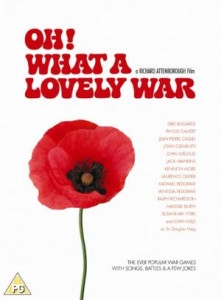Oh! What A Lovely War
Joan Littlewood’s stage production Oh! What a Lovely War has long been a favourite with students and teachers. Long unavailable on home video, Richard Attenborough’s 1968 film adaptation in now out on as a special edition DVD. Michael Paris, Emeritus Professor of Modern History at the University of Central Lancashire, considers it in the context of other representations of war in the cinema and on television and discusses its standing as both drama and history.
About the author: Michael Paris is Emeritus Professor of Modern History at the University of Central Lancashire. He has taught at Open University, Middlesex University and in adult education before coming to UCLan. He is a specialist in war and popular culture of C20. He was elected fellow of Royal Historical Society and The British Commission for Military History. His publications include: The Novels of World War Two: An Annotated Bibliography (1990)
 Apart from a handful of openly celebratory films made in the early 1920s, British filmmakers have generally seemed unsure about how to represent the Great War – a triumph of perseverance and heroic struggle resulting in a decisive British victory – or a journey through hell for the soldiers who, led by incompetent generals, were sent into the mincing machine of the Western Front in a futile war of attrition. This ambiguity is clearly evident in the two most celebrated pre-1939 films about the war, Journey’s End (James Whale, 1930) and Tell England (Anthony Asquith, 1931), which can easily be read as either essays in patriotism, honour and the conventions of duty, or as a bitter indictment of the futility of the war. After 1939, the Great War virtually disappeared from the screen and other media, displaced by a second and obviously unambiguous conflict, until the 1960s when the approach of the fiftieth anniversary of 1914 sparked renewed interest among a new generation of historians, television producers and filmmakers.
Apart from a handful of openly celebratory films made in the early 1920s, British filmmakers have generally seemed unsure about how to represent the Great War – a triumph of perseverance and heroic struggle resulting in a decisive British victory – or a journey through hell for the soldiers who, led by incompetent generals, were sent into the mincing machine of the Western Front in a futile war of attrition. This ambiguity is clearly evident in the two most celebrated pre-1939 films about the war, Journey’s End (James Whale, 1930) and Tell England (Anthony Asquith, 1931), which can easily be read as either essays in patriotism, honour and the conventions of duty, or as a bitter indictment of the futility of the war. After 1939, the Great War virtually disappeared from the screen and other media, displaced by a second and obviously unambiguous conflict, until the 1960s when the approach of the fiftieth anniversary of 1914 sparked renewed interest among a new generation of historians, television producers and filmmakers.
The popular perception of the war in the 1960s was established by several best-selling historical studies that condemned the futility and waste and cast the generals, particularly Haig, as incompetent ‘donkeys’. These accounts were reinforced by the BBC’s popular television documentary series The Great War (1964), which drew an average audience of eight million viewers for each episode, and which for almost the first time enabled the public to actually see the full horror of the war through actuality footage. And at the end of that decade came Richard Attenborough’s Oh! What A Lovely War – a wonderfully entertaining but moving kaleidoscopic history of the war that seemed to synthesise current historical interpretations of the war.
Derived from Joan Littlewood’s stage show of the same name, the film was Attenborough’s debut as director and a more difficult first project would be hard to imagine. The film portrays the war as a seaside entertainment – a tacky review on Brighton Pier – ‘WORLD WAR ONE’, the advertising proclaims, ‘BATTLES, SONGS AND A FEW JOKES’. The sketches, interspersed with more conventionally filmed scenes in the trenches, convey a breathless impression of the war: the hysterically patriotic mood of 1914 when the war was expected to be romantic, exciting, and over by Christmas, and the incomparable Maggie Smith as a glamorous musical hall star enticing gullible young men to enlist with the promise of glory and sexual favours. But in the trenches, there is little adventure, just the awful realisation that war is not glorious but bloody and brutal.
 Learning on Screen
Learning on Screen